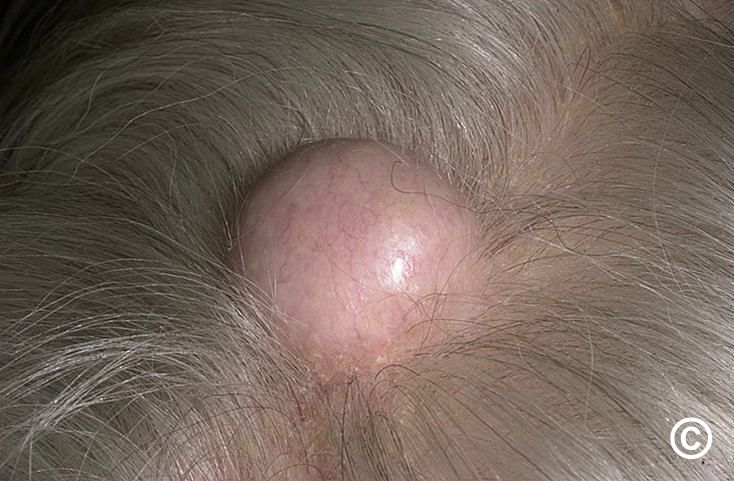What are the symptoms of a pilar cyst?
A pilar cyst, also known as a trichilemmal cyst, is a benign, fluid-filled sac that typically forms on the scalp. Here are the common symptoms:
Symptoms of a Pilar Cyst:
- Smooth, Round Lump:
- Appearance: A pilar cyst is usually a round, firm lump that feels smooth and mobile under the skin.
- Size: It can vary in size from a few millimeters to several centimeters in diameter.
- Location:
- Scalp: Most commonly found on the scalp, but can occasionally appear on other areas of the body.
- Single or Multiple: May appear as a single cyst or multiple cysts.
- Non-Tender:
- Pain: Generally, pilar cysts are not painful or tender unless they become infected or inflamed.
- No Significant Changes:
- Growth: They usually grow slowly and do not change significantly in size.
- Surface: The surface may appear smooth or slightly wrinkled.
- Possible Discomfort:
- Pressure: If the cyst becomes large, it might cause discomfort due to pressure on surrounding tissues.
- Possible Infection Signs:
- Redness and Swelling: If the cyst becomes infected, it may become red, swollen, and tender, and there could be pus or other discharge.
Summary:
A pilar cyst is generally a benign and asymptomatic growth that appears as a smooth, round lump, typically on the scalp. It may not cause significant problems unless it becomes infected or inflamed. If you notice changes in a pilar cyst or experience discomfort, it’s advisable to consult a healthcare provider for evaluation and possible treatment.
What are the causes of a pilar cyst?
Pilar cysts, also known as trichilemmal cysts, are benign growths that primarily occur on the scalp but can also appear on other parts of the body. The exact cause of pilar cysts is not always clear, but several factors are thought to contribute to their development:
Causes of Pilar Cysts:
- Hair Follicle Abnormalities:
- Formation: Pilar cysts originate from hair follicles, specifically from the cells in the outer root sheath of the hair follicle. Abnormalities or disruptions in the normal growth and shedding process of hair follicles can lead to cyst formation.
- Genetic Factors:
- Inheritance: There is a hereditary component to pilar cysts. They can run in families, suggesting a genetic predisposition. Individuals with a family history of pilar cysts or similar skin conditions are more likely to develop them.
- Hormonal Changes:
- Influence: Hormonal fluctuations, such as those occurring during puberty or pregnancy, may influence the development of pilar cysts, although this link is not as strongly established as in some other skin conditions.
- Chronic Irritation or Trauma:
- Mechanism: Repeated physical irritation or trauma to the skin, such as frequent scratching or shaving, might contribute to the formation of pilar cysts by causing inflammation or damage to the hair follicles.
- Aging:
- Age-Related Changes: Pilar cysts are more common in adults, particularly in middle-aged individuals, indicating that age-related changes in skin and hair follicles may play a role in their development.
- Underlying Skin Conditions:
- Association: Certain skin conditions or syndromes that affect hair follicles, such as steatocystoma multiplex or Gardner’s syndrome, can be associated with an increased likelihood of developing pilar cysts.
Summary:
Pilar cysts are primarily caused by abnormalities in hair follicle cells and can be influenced by genetic factors, hormonal changes, chronic irritation, aging, and underlying skin conditions. They are generally benign and occur most commonly on the scalp. If you have concerns about a pilar cyst or notice any changes, consulting with a healthcare provider for evaluation and appropriate management is recommended.
What is the treatment for a pilar cyst?
The treatment for a pilar cyst typically depends on whether the cyst is causing symptoms, such as pain or discomfort, or if it is simply a cosmetic concern. Here are common treatment options:
Treatment for Pilar Cysts:
- Observation:
- Asymptomatic Cysts: If the pilar cyst is small, asymptomatic, and not causing any issues, a healthcare provider might recommend simply monitoring it without immediate intervention.
- Surgical Removal:
- Indications: If the cyst is large, painful, infected, or causing cosmetic concerns, surgical removal is often recommended.
- Procedure: The cyst is usually excised under local anesthesia. The procedure involves making a small incision to remove the cyst and its capsule, which helps prevent recurrence. This is typically done in an outpatient setting.
- Drainage:
- Temporary Relief: If the cyst is inflamed or infected, drainage might be performed to relieve pressure and remove any pus or fluid. However, this is often a temporary measure and may not prevent the cyst from recurring.
- Not a Permanent Solution: Drainage does not remove the cyst wall, so the cyst may reform over time.
- Treatment for Infection:
- Antibiotics: If the pilar cyst becomes infected, antibiotics may be prescribed to treat the infection. The cyst may need to be drained as part of the treatment.
- Avoidance of Irritation:
- Preventing Recurrence: Avoiding repetitive trauma or irritation to the area where the cyst is located may help reduce the likelihood of recurrence.
Summary:
Treatment for a pilar cyst may involve observation if it is asymptomatic. If the cyst causes discomfort or other issues, surgical removal is the most effective option. In cases of infection, antibiotics and drainage may be necessary. Regular monitoring and avoiding irritation can help manage the cyst and reduce the risk of recurrence.

Leave a Reply
You must be logged in to post a comment.